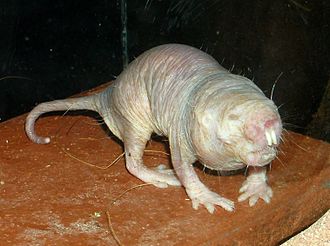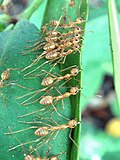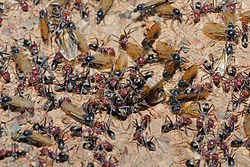Eusociality
Eusociality is a term in animal behaviour for the more complex kinds of social organisation. The term "eusocial" was introduced in 1966 by Suzanne Batra.[1] E.O. Wilson gave it a more precise meaning.[2]
Meaning of the term
At the start, it was used for invertebrates only, usually social insects. These are its main features:[3][4]
- Different animals have different jobs to do. There is a division of labour. Some castes may be sterile.
- Animal generations overlap. There are different generations in the hive or nest.
- Animals cooperate to care for the young.
Presociality is a term for simpler (basal) kinds of sociality.
Definition debates
After Wilson's original definition, others discussed it, and some wanted to change its details.[5][6][7]
Examples
The most familiar examples of eusociality are insects such as ants, bees, wasps, and termites. All of these are colonial animals which have queens for reproduction. The animals that are workers or soldiers are usually sterile - they cannot have offspring.
There were only two known mammal species which are eusocial. These are the naked mole rat and the Damaraland mole rat.[8]
Eusociality with sterile individuals is the most extreme form of kin altruism. They do specialized tasks, often caring for the reproductive members. It includes individuals whose behaviour, body shape and function is modified for group defence, including self-sacrifice (altruism).
Eusociality played a key role in the development of theories in sociobiology.
Naked mole rat
Naked mole rats are eusocial mammals. Colonies averaging 75-80 individuals live together in complex systems of burrows in arid African deserts. The tunnel systems built by naked mole rats can stretch up to two or three miles in cumulative length.[9]
Other examples
Recently, some species of gall-making aphids (Order Hemiptera) and thrips (Order Thysanoptera) are eusocial, with many separate origins of the state (convergent evolution). These species have extremely high relatedness between individuals. This is due to their mode of reproduction: sterile soldier castes are of the same clone as the reproducing female. The gall-inhabiting behavior gives these species a resource which sets them apart from related species with similar genetics. In these groups, therefore, high relatedness alone does not lead to the evolution of social behavior, but requires that groups occur in a restricted, shared area.[10]
Similarly, eusociality occurs in some crustaceans and other arthropods. On some tropical reefs, several species of minute Synalpheus pistol shrimp are eusocial. They depend on certain sponges for the survival of their colony,[11] and have a single breeding female and a number of male defenders armed with large snapping claws. Again, there is a single shared domicile for the colony members, and the non-breeding members act to defend it.[12]
Theories of social evolution
In colonies of eusocial animals, some animals are sterile. They can not pass on their genes at all. How can these animals evolve and persist? Since they do not breed, their fitness should be zero and any genes causing this condition should be eliminated from the population immediately. In On the Origin of Species, Darwin called this eusocial behavior the "one special difficulty, which at first appeared to me insuperable, and actually fatal to my theory".[13][14] Darwin thought that the resolution to the paradox would lie in the close family relationship.
Darwin could not say more because he did no know what the mechanism of heredity was. The first explanations were kin selection, and inclusive fitness. Both rely on the discovery of how genes are inherited. This discovery was made after Darwin had published On the Origin of Species, and not understood until after 1900.
Early ideas on eusociality included suggestions that trophallaxis or food sharing was a basis for sociality.[15] The most widely accepted model to explain eusociality is based on W.D. Hamilton's idea of inclusive fitness.[16]
Inclusive fitness
Haplodiploidy determines the sex in all members of the insect order Hymenoptera (bees, ants, and wasps), and the Thysanoptera ('thrips').[17]p408
In this system, sex is determined by the number of sets of chromosomes an individual receives. An offspring formed from the union of a sperm and an egg develops as a female, and an unfertilized egg develops as a male. This means that the males have half the number of chromosomes that a female has, and so are haploid.
The haplodiploid sex-determination system has a number of peculiarities. Most importantly, the relatedness between the sisterhood of worker bees in a hive or nest is 0.75. This means the workers are significantly more closely related than siblings in other sex determination systems.[18] It is this point which drives the kin selection theory of how eusociality evolved.[17]p465[19][20]
Consequences
If the theory of inclusive fitness is accurate, the haplodiploidy makes kin selection easier. Sisters are more related to each other than to any offspring they might have. Hamilton called them supersisters. On average, two supersisters have 75 percent of the same genes. If they breed, they would share only half of their genome with their offspring. From the selfish gene's point-of-view, it is better to raise more sisters. Even though workers often do not reproduce, they are potentially passing on more of their genes by caring for sisters than they would by having their own offspring.
This unusual situation may explain why eusociality evolved several times in the haplodiploid group Hymenoptera — ants, bees and wasps. As of 2009, 11 separate cases are known. However, Hymenoptera is a large group and the majority of its species are not social. Furthermore, highly developed eusociality also exists in non-hymenopterans, perhaps most obviously in termites. Most such cases involve organisms that display high levels of inbreeding, so that colony members share more than half of their genes. Therefore the same model is considered to apply to these species.
Reeve and Holldobler put forward a theory of a superorganism.[21] They look at competition and co-operation between groups as well as within groups. In their model, an individual's inclusive fitness varies according to how much it invests in within-group competition (e.g. hoarding a private food cache) versus between-group competition (e.g. contributing to common foraging); and on its relatedness to the other group members.
In a colony with one breeder (queen) and many workers, the evolutionarily stable state is for each individual to invest entirely in helping the group. This leads to a perfect "superorganism". In other words, the eusociality is stable, a result that agrees with Hamilton's findings. Also, they show that the effect is reinforced if there are many groups competing for the same resources.
Eusociality Media
Co-operative brood rearing, seen here in honeybees, is a condition of eusociality.
Suzanne Batra introduced the term "eusocial" after studying nesting in Halictid bees including Halictus latisignatus, pictured.
Weaver ants, here collaborating to pull nest leaves together, can be considered eusocial, as they have a permanent division of labor.
Swarming Iridomyrmex purpureus ants. The young queens are black, winged, and much larger than the wingless workers.
Myrmecocystus honeypot ants, showing the repletes or plerergates, their abdomens swollen to store honey (top), with ordinary workers (bottom)
Termites live in large nests, with queen, king, soldier (red heads), and worker (pale heads) castes.
Model of naked mole-rat burrow with soldiers, workers, and queen, a social structure similar to the castes of the eusocial insects
The staghorn fern Platycerium bifurcatum may display a simple form of eusociality.
Related pages
References
- ↑ Batra S.W.T. 1966. Nests and social behavior of halictine bees of India (Hymenoptera: Halictidae). Indian J. Entomol 28 375-393.
- ↑ Wilson E.O. 1971. The insect societies. Harvard University Press. Cambridge. Massachusetts.
- ↑ Michener C.D. 1969. Ann. Rev. Entomol. 14, 299-342.
- ↑ Gadagkar, Raghavendra 1993. And now... eusocial thrips!. Current Science 64(4) 215-216. PDF[dead link]
- ↑ Crespi B.J. and Yanega D. 1995. The definition of eusociality. Behav. Ecol. 6, 109–115
- ↑ Kevin R. Foster & Francis L.W. Ratnieks 2005. A new eusocial vertebrate? Trends in Ecology and Evolution 20(7):363-364 PDF Archived 2009-02-24 at the Wayback Machine
- ↑ James T. Costa & Terrence D. Fitzgerald 2005. Social terminology revisited: where are we ten years later? Ann. Zool. Fennici 42:559-564 PDF
- ↑ Burda H. Honeycutt R.L. Begall S. Locker-Grutjen O & Scharff A. 2000. Are naked and common mole-rats eusocial and if so, why? Behavioral Ecology and Sociobiology 47 293-303 Abstract Archived 2016-03-04 at the Wayback Machine
- ↑ Dawkins, Richard (1976). The Selfish Gene. Oxford University Press. ISBN 0-19-286092-5.
- ↑ Crespi B.J. 1992 Eusociality in Australian gall thrips. Nature 359: 724-726.
- ↑ Duffy, J. Emmett; Morrison, Cheryl L.; Rí;os, Rubé;n (2000). "Multiple origins of eusociality among sponge-dwelling shrimps (Synalpheus)". Evolution. 54 (2): 503–516. doi:10.1111/j.0014-3820.2000.tb00053.x. PMID 10937227. S2CID 1088840.
{{cite journal}}: CS1 maint: multiple names: authors list (link) - ↑ Duffy, J. E (1998). "On the frequency of eusociality in snapping shrimps (Decapoda : Alpheidae), with description of a second eusocial species". Bulletin of Marine Science. 63 (2): 387–400.
- ↑ Darwin, Charles 1859. The origin of species. London:Murray. Chapter 7, p236
- ↑ Costa, James T. 2009. The annotated origin. Harvard, p236.
- ↑ Wheeler W.M. 1918. A study of some ant larvae with a consideration of the origin and meaning of social habits among insects. Proc. Am. Phil. Soc. 57, 293-343.
- ↑ Hamilton, William D. 1996. Narrow roads of geneland. Freeman. Chapter 2, Hamilton's rule pp 14–30.
- ↑ 17.0 17.1 Grimaldi D. and Engel M.S. 2005. The evolution of the insects. Cambridge University Press. ISBN 0-521-82149-5
- ↑ The relatedness of siblings is usually 0.5.
- ↑ Hamilton W.D. 1964. The genetical evolution of social behaviour, I and II. Journal of Theoretical Biology 7, 1–52. Reprinted with comments in Hamilton W.D. 1996. Narrow roads of geneland, volume I Evolution of social behaviour. Freeman/Spektrum, Oxford. ISBN 0-7167-4530-5
- ↑ Hughes W.O.H.; et al. (2008). "Ancestral monogamy shows kin selection is key to the evolution of eusociality". Science. 320 (5880): 1213–1216. doi:10.1126/science.1156108. PMID 18511689. S2CID 20388889. Retrieved 2008-08-04.
- ↑ Reeve H.K. and Hölldobler B. 2007. The emergence of a superorganism through intergroup competition. Proceedings of the National Academy of Sciences 104: 9736-9740










